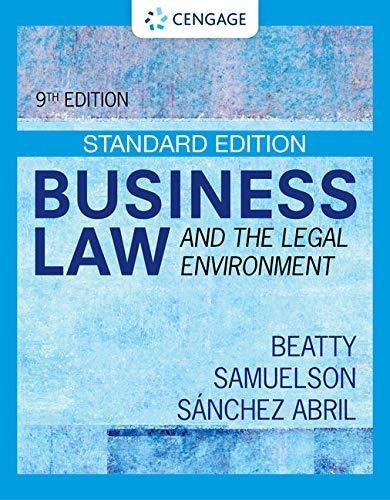Question
Alison Abel has consulted you in relation to making a claim on behalf of the Purinta people, with regard to land in the Eastern Kimberley
Alison Abel has consulted you in relation to making a claim on behalf of the Purinta people, with regard to land in the Eastern Kimberley area of Western Australia. Apart from the township of Kununurra (which is all owned under fee simple titles), and Scrubby Station (also owned under fee simple title), this land is held under pastoral leases granted pursuant to the Western Australian Land Acts 1902 and 1959. The provisions of these Acts, read together with the terms of the pastoral leases over traditional Purinta land, do not confer exclusive possession to the lessee, but an interest more akin to a grazing right.
Alison's mother is a Purinta woman. Her father is not of indigenous background. For many years he managed a cattle station (that is not the subject of the present native title claim).
Under Purinta law and custom, both males and females receive traditional knowledge specific to their gender.
Alison's mother passed a wide range of traditional knowledge down to her. It includes detailed knowledge of native plants for eating and medicinal purposes, understanding of the ceremonies relating to sacred sites on the land and their significance in Dreamtime creation stories, the system of kinship (or skin groups) correlating to Purinta names and marriage traditions, and the spiritual relationship between these skin groups and their totem animals. Since childhood, Alison has been involved in ceremonies at the sacred sites on Purinta land that are particular to women. These ceremonies are conducted in the Purinta language. Although Alison's family speaks English at home, her mother has taught her enough of the Purinta language to participate in Purinta ceremonial life, and to transmit the Purinta traditional culture to her own children when the time comes.
The Purinta have not lived on the land the subject of the proposed native title claim for several generations. In the late nineteenth century, the Purinta were forcibly removed from their land. This followed a series of spearings of cattle that had been consuming scarce water at rockholes and springs, and polluting the water there. For some decades the Purinta were compelled to live at Mission stations, where sustained efforts were made to replace their traditional customs with European beliefs and culture. In the years following first contact with Europeans, a large proportion of the Purinta died from disease, and many children were forcibly separated from their families. Many Purinta men worked on cattle stations, and many Purinta women worked in domestic service. Whilst most Purinta did their best to 'go on walkabout' and visit their ancestral lands for ceremonial purposes, this was not always possible.
These days, many Purinta who are not working in the pastoral industry live in Kununurra. The level of commitment to traditional culture amongst Purinta there is variable, particularly among the younger generation. Nonetheless there have always been substantial groups of Purinta men and women that have maintained ceremonies at the traditional sacred sites. These ceremonies have always been tolerated by the pastoral leaseholders, as it seemed to keep the Purinta workers happy and wasn't interfering with cattle grazing. The same reasoning was applied to Purinta hunting of kangaroos and other native species, and gathering plants on their traditional land. These days most hunting is done with .22 rifles not spears, often from 4 wheel drive vehicles.
Accounts of explorers and early pastoralists recorded that aboriginal ceremonies were taking place in the late nineteenth century at the same sites as the Purinta are conducting ceremonies today. There is no detailed anthropological or other documentary evidence relating to the content of the ceremonies, or its relationship with any traditional rights to the land. The early accounts indicate that while the Purinta predominantly lived in the open, in the wet season they built bark huts. At the present time, several Purinta families are living in prefabricated metal outstations on traditional Purinta land.
Part of the land under the proposed native title claim is in the town of Kununurra. There is a Purinta Cultural Centre in Kununurra, where the Purinta language is predominantly spoken, and traditional paintings relating to Purinta land are produced. Many of these paintings represent landmarks of spiritual significance to the Purinta. One reason for the maintenance of the cultural centre is to ensure that Purinta children growing up in an urban environment, studying in mainstream Australian schools and contemplating careers in the broader economy do not lose their spiritual links to their traditional land and culture.
Advise Alison on the likely prospects of the Purintanative title claim. (Answer must include legislation or case evidence)
Step by Step Solution
There are 3 Steps involved in it
Step: 1

Get Instant Access to Expert-Tailored Solutions
See step-by-step solutions with expert insights and AI powered tools for academic success
Step: 2

Step: 3

Ace Your Homework with AI
Get the answers you need in no time with our AI-driven, step-by-step assistance
Get Started


